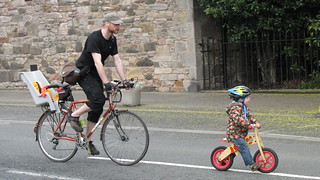"The old hands know that the secret is to transfer bidons from the frame to your pocket before ascending a hill, to lower the bike weight."
Yeah but...??
CityCyclingEdinburgh was launched on the 27th of October 2009 as "an experiment".
IT’S TRUE!
CCE is 16years old!
Well done to ALL posters
It soon became useful and entertaining. There are regular posters, people who add useful info occasionally and plenty more who drop by to watch. That's fine. If you want to add news/comments it's easy to register and become a member.
RULES No personal insults. No swearing.

"The old hands know that the secret is to transfer bidons from the frame to your pocket before ascending a hill, to lower the bike weight."
Yeah but...??
More weight pushing the pedals down, less weight on the bike to be propelled upwards...?
Hmm didn't know that...
I know I used to fill up every 2 weeks when I drove to work in East Anglia but when fuel hit ~£1.30 in ~2006 (first time round) I started filling to half full every week instead as I was carrying less weight to work and back.
Yeah but...??
Genuine grimpeurs and grimpeuses will of course drink the contents of the bottle first, before putting it in their pocket. For maximum weight reduction.
You could carry a ten litre water bottle on your back, but not fill it. Instant 10kg weight saving - that's a whole bike's worth!
Arellcat said "You could carry a ten litre water bottle on your back, but not fill it. Instant 10kg weight saving - that's a whole bike's worth!"
Wow I knew parts of Sighthill were less salubrious but didin't realise they had become a desert!! ;o)
I'm not convinced that making cars safe increases their weight greatly. It is possible to build strong safety cages and impact absorbing crumple zones through good design and standard materials.
What adds weight to cars is luxury and more interior space. A 1986 Mini had a heater and you wound the windows down by hand. If you were lucky you had a radio.
Modern cars have power steering; electric motors to drive the windows and mirrors; sumptuous padded heated leather seats with more motors to move them; central locking; sound deadening material everywhere; air conditioning units; pollen filters; larger diameter wheels to soak up the bumps; 6 speaker 'pumping' sound system; cup holders left, right and centre; automatic handbraking systems... and so on... it all adds up to a huge increase in weight.
Then, as other posters have pointed out, as the weight goes up, the suspension components have to be beefed up, the engine size 'needs' to go up, the brakes and the wheels have to be made larger and more fuel needs to be carried.
Result: Frequent situations on ordinary city streets where 2 Trinity Tractors cannot pass one another.
Alright I'll bite.
1970 Mini - 610kg
VW Up - 929
They're the closet thing to the same size but for a daily user I know what I'd prefer. Especially when you see the fuel consumption. Now I can't find a NCAP rating for the mini but I'd not like to be by any thing bigger than my coxwane on his balance bike.
1970 Mini - 45mpg*
VW Up - 63mpg
*internet hearsay, many quote it much much worse.
Up a class
Morris Marina - 988kg 25mpg
Puegeot 308 - 1370 53mpg
Up again
Cortina Mk3 (1970) - 1100kg 24.6 mpg
Mondeo Mk3 - 1400kg 35mpg
And finally
1970 rangrover 1750kg - 15-25mpg
2012 rangerover 2200kg - 37.7
So yes all the cars are heavier they're also more comfortable, safer for every one* and consume much less fuel than their predecessors.
*European vehicle specifications include pedestrian safety in the design adding to weight as some components have to be heavier and lower down to push the pedestrian over the bonnet rather than under the wheels.
Multiple post due to scotfails continuing lack of wifi and terrible phone signal. Sorry!
So a car with a 1970s weight but a 2010s engine efficiency should be doing quite something when it comes to MPG then?
All other things being equal, I'd rather be hit by a 750kg car doing 20mph than a 1500kg car doing the same speed...
Some interesting numbers, and cars are certainly on the whole safer than they were twenty years ago, and yet..
Airbags are still touted as a wonderful safety feature, but let's look at them, the only reason you might need one is to prevent you hitting the interior of the car, or it hitting you. If the safety cell holds, and your seat and seatbelt do their job there is ne need for them. Ahhh you say, but surely they are meant for extreme and unpredictable impacts?
Well I'll acknowledge my ignorance of modern specs, but a mid 90's golf, considered to be a safe car for it's day, had airbags designed to go off if it was involved in an impact at 30mph or over with any stationary object.
Let's think on that for a moment,for a 100mph+ car,sold in a country where it's legal to do 70mph, the manufacturer considers it likely the safety cell may fail in impacts over 30mph, or head on into another golf if they're both exceeding 15mph...
Yet we can relatively cheaply modify them for the track in such a way that far bigger impacts are surviveable.
But they really care lots about the safety of their customers right? Or do they care more that restrictive seatbelts, fixed back seats and ugly rollcages aren't good for car sales because they remind occupants just how vulnerable they really are?
"All other things being equal, I'd rather be hit by a 750kg car doing 20mph than a 1500kg car doing the same speed2
But that's part of the point, things aren't necessarily equal. Some of the extra weight is down to better protection for pedestrians. Power steering and ABS must surely be considered to be safety items that are worth the weight? I'll wonder if the fancier, more fuel-efficient engines are also heavier than their counterparts too?
In reality, being hit by a 750kg car compared to a 1500kg car at the same speed would make the weight irrelevant anyway wouldn't it?* (which would make the more modern car, with pedestrian safety items, much much safer to be hit by (as well as having the safety features that make you less likely to be hit in the first place anyway)).
*I'm no physicist so this may be wildly incorrect.
Smudge, whilst cars could undoubtedly be safer you soon hit the diminishing returns. Taking a purely hard headed look at it, what percentage of lives could be saved by making cars even safer? I agree the majority of modern safety features are marketing, a four point harness would be much better and just as easy to use. But for the most part cars are safe enough, looking at the mile per mortality rate its pretty clear car travel is fairly safe. So even making all cars conform to track regulations how many lives do we expect to save? You'll never stop people driving into big heavy things so do we remove all concrete barriers from motorways? Must be design roads like race tracks to save people from them selves?
All things are a cost benefit scale where you place the pointer is a matter for debate. Money would be better spent on road safety and teaching people to be less stupid rather than throwing it towards making the cage better.
In reality, being hit by a 750kg car compared to a 1500kg car at the same speed would make the weight irrelevant anyway wouldn't it?*
No it would be 1.25 as bad, in a purely physics formulation. Kinetic Energy = 1/2mass x 2(velocity).
30mph = 13.4 m/s
Cortina = 1100kg = 550kg x (13.4x2) = 14740 kj
Mondeo = 1400kg = 700kg x (13.4x2) = 18760 kj
Diff = 4020 kg = 21% of the Mondeos energy.
I'd rather be hit by a ton of marshmallows than half a ton of bricks, showing that the weight is mainly incidental to the example..?
Power steering allows a heavy(ier) vehicle to go round a tight corner (like a city junction) much faster than the same vehicle with manual steering.
Think of an old fashioned bus, with an enormous steering wheel. You had to wrench the wheel several turns in one direction, drive round the corner at 1mph, then wrench the wheel back again several turns.
We used to own a 88 Transit Camper with manual steering. The steering wheel was enormous. If you entered a city corner too quickly, you would get the nasty surprise of being unable to wind the steering wheel back quickly enough to avoid continuing the turn too far, and then having to hit the brakes.
With a power steering van, you can just flick the wheel half a turn or so, and go round the same corner much like a car.
So I see power steering as making larger vehicles less safe in the city
@Steveo, fair point, I'm probably getting a bit sidetracked/lost in the comparison of cars lightly modified for safety v manufacturers ""safe" cars. My general point is that outside of a marketing tool or the potential for adverse headlines they (as organisations) couldn't give a tinkers cuss about the safety of the occupants or those around them. It's all playing around the edges and marketing smoke and mirrors, nothing at all has really changed since Ford were caught calculating that it was cheaper to buy off burns victims/relatives than fix the Pinto.
If they actually cared at all about safety their products would be governed down to the national maximum speed limit (cheap or free) and variable speed limiters would be a factory option. (I'm actually genuinely surprised no-one has marketed these to parents yet!).
Must try to be less cynical/realistic sometimes, I'm turning into a grumpy old man!
Cortina = 1100kg = 550kg x (13.4x2) = 14740 kj
Mondeo = 1400kg = 700kg x (13.4x2) = 18760 kj
If I may interject, at 30mph the Cortina would have 98.6 kJ of kinetic energy, and the Mondeo would have 125.5 kJ. Ek=1/2 mv^2, remember. For the same velocity the increase in mass (27%) is directly proportional to the increase in energy.
By way of comparison, when I'm riding home at 25mph, I have a kinetic energy of 5.9 kJ. If I'm out jogging, it might be 0.3 kJ.
"the manufacturer considers it likely the safety cell may fail in impacts over 30mph, or head on into another golf if they're both exceeding 15mph..."
They'd both need to be exceeding 30mph.
@CB, I'm being dumb, why's that? If it's designed to be set off by hitting a stationary object at 30mph, surely a closing speed of 30mph into an identical object would also reach the critical impact force?
Either way, less than half it's acceptable and legal (maximum) speed of use is surely a *very* low speed to anticipate the primary safety equipment could fail?
Thanks, I am indeed being dumb and I should know better (blushes) I'm blaming a sleepless toddler in the house and shuffling away sharpish :-o
Hey, even Myth Busters got it wrong.
(Actually, I only watched that programme once and found it very annoying, can't remember why exactly, but it was def. annoying).
Wilmanth: I'm no physicist so this may be wildly incorrect.
You'd need to be in a very generous mood to call me one too, but...
You're right. Divide your mass by the vehicle's mass.
Take that number, pet it and hug it and call it George.
George is a fraction and he is roughly how much the vehicle is going to slow down during a collision with you, after which you will both be going at the same speed.
Accelerating very quickly is extremely bad for you so the lower this new speed is the better.
But let's go back and look at George. When it comes to a motor vehicle hitting a cyclist, George is always going to be small.
Teeeeeeny 750kg car versus a person on a maximally laden WorkCycles Fr8(which is the most absurdly overengineered bike I'm aware of) and George is about 1/3rd. That still means the cyclist is accelerated up to 2/3rd of the car's original speed in the time it takes to get hit by a car.
Behemoth 2500kg Chelsea Tractor a versus stick insect roadie on a barely legal UCI device and George is about 1/36th, so the poor carbonite gets taken up to 35/36th of the original speed.
The difference between the worst-case of 35/36th and best case of 2/3th is only 11/36th. Not even a third, so yeah...makes no bones how heavy the vehicle is; the geometry of the impact site matters way more.
NB: the actual equation for George is m/(m+M) where m is the cyclist and bike, and M is the vehicle, but it makes George uglier and makes no real difference compared to the other inaccuracies and assumptions made in this post.
Am I being unreasonable in thinking you really shouldn't be allowed to drive a car until you know this with same familiarity as you know that you have to watch toast really carefully the second time you press it down?
For the record, I'd rather not be hit.
I saw today that Ford have signed a deal to offer Spotify in their cars over the in-car entertainment system. I think they are going down the transition to being a hifi and sofa company who just happen to make cars to put their products in.
If I may interject,
My mistake, can't remember what is 2V (opposed to v^2 as it pointed out). Also managed to type my units wrong... I really shouldn't try physics...
On the other hand my finger in the air 25% difference was pretty close!
So if fuel is so expensive why do people:-
- Accelerate past bikes (or other traffic) to get to a red light?
- Rather than glide up to red lights, maintain a constant throttle then brake hard?
- Leave their engine running for about 5 minutes whilst they empty their car at the tip?
You must log in to post.

 Cycling in Edinburgh Flickr group
Cycling in Edinburgh Flickr group
Video embedded using Easy Video Embed plugin